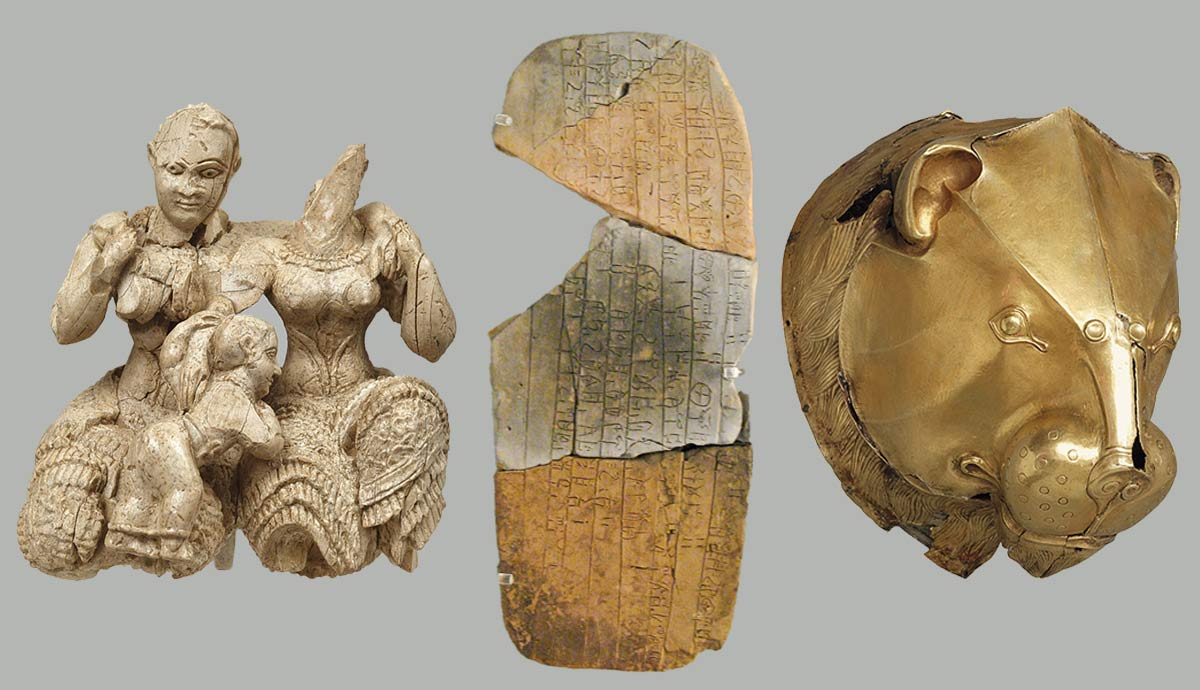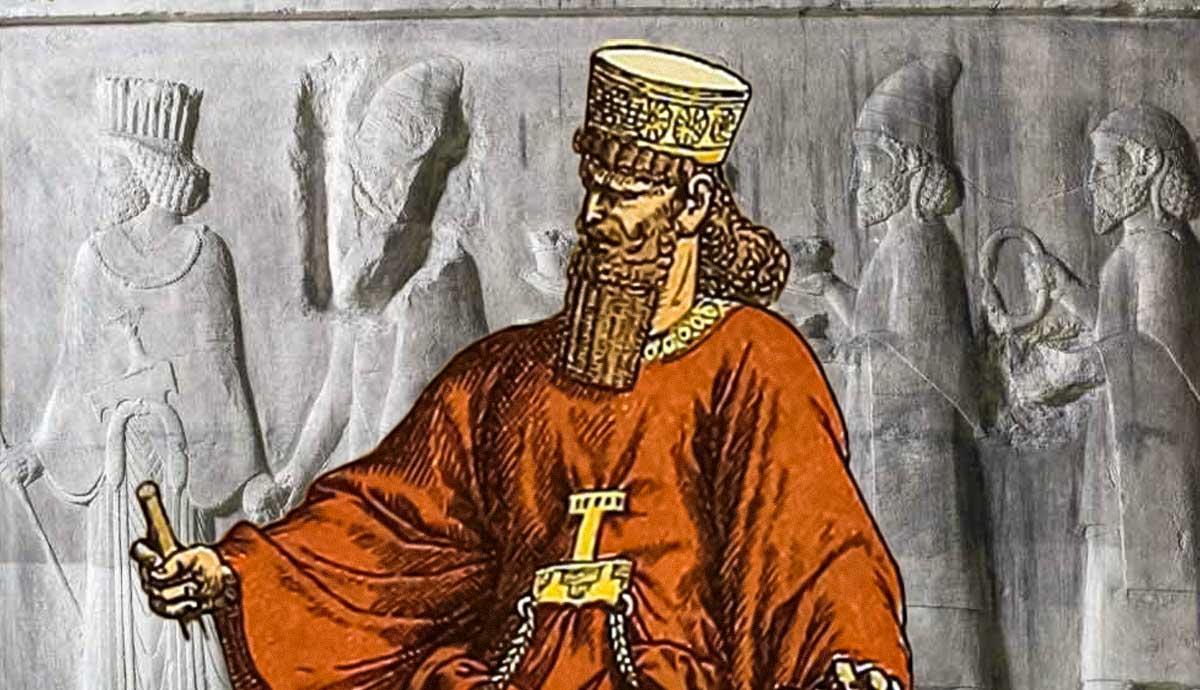
Linear B, the Mycenaean writing system, was long considered indecipherable. However, in the 1950s, it was proposed that the script was an early form of Greek. Correct in their hypothesis, linguists have now translated thousands of Linear B tablets. Though the Mycenaeans seem only to have used writing for administrative purposes, there are familiar-sounding names hidden within the bureaucracy: Po-se-da-o, Di-wo, E-ma-ha. These were early forms of Poseidon, Zeus, and Hermes. These were the Olympian gods, five centuries before they were supposed to exist. According to the surviving Linear B evidence, which gods were on the divine roll call for the Mycenaeans?
Who Were the Mycenaeans?

Long before us, the Ancient Greeks had an idea of their own antiquity. They told stories of bronze-clad heroes who journeyed throughout the Mediterranean fighting monsters, rescuing maidens, and stealing priceless treasures from the clutches of dragons. They wielded bronze weapons, lived in magnificent palaces, and were as valiant as they were violent. If not a peaceful age, it was a noble one. This was the Greek perception of their Mycenaean ancestors. It is not entirely false; archaeology shows us that the Mycenaeans were a martial culture who traveled the Mediterranean and ruled kingdoms from hilltop palaces. And just like the later Greeks intuited in the Homeric myths, those heroes of bronze worshiped primeval forms of the Olympian Gods.
Their civilization lasted from about 1750 BCE to 1050 BCE and was centered on the Greek mainland. Mycenaean culture spread across the Aegean Sea to Crete and Anatolia, where it came into contact with the Egyptians, Hittites, and other Bronze Age civilizations. It was part of a broader Mediterranean trade system and a more local economy based around its palace complexes. From atop his citadel, a Mycenaean Xanax (king) could do much more than engage in international trade; he could get his paperwork in order.
What Do We Know About Linear B?

No written narratives come from the Mycenaeans. They had far more practical uses for writing, mainly administrative. On clay tablets, bureaucrats wrote catalogs of goods coming in and out of their strongholds, as well as their intended uses. One example from Knossos on Crete would dedicate “in the month of Deukios / to Diktaean Zeus / oil 9.6 liters” (a “/” represents a line change). The Mycenaeans developed a writing system called Linear B, which was adopted from the nearby Minoan civilization’s Linear A. Linear A has never been deciphered and is likely part of a completely different language family than Linear B. Both languages, however, use almost all the same characters.
There are close to 200 characters in Linear B, which represent individual phonemes and ideograms (symbols that represent ideas or concepts). For example, the combination of the phonemic characters 𐀇 and 𐀺, “di” and “wo,” combine to make the word 𐀇𐀺, di-wo. Deciphering Linear B and confirming that it was a very early form of Greek also gave us some clues into who the Mycenaeans were: Indo-Europeans.
Were the Mycenaeans Early Indo-Europeans?

Minoan Linear A likely represents an archaic European language, one that predates the spread of the Indo-European language in Greece. Linear B, however, coincides with the arrival of said Eurasian language in the area, that of the Mycenaeans. There are elements of the Mycenaean Linear B that are indigenous to the Aegean, mainly place names. This implies that, linguistically, the Mycenaeans were a genetic, cultural, linguistic, and religious mixture of foreign Indo-Europeans and local Aegean peoples.
Perhaps the most famous Greek god, Zeus, is not even indigenous to Greece. As an Indo-European language, the linguistic ancestor of Mycenaean developed on the Eurasian steppe somewhere around the 4th millennium BCE. Due to the similarities between the languages in the Indo-European family (like English, French, Russian, and Hindi), it is proposed that they all stem from said common ancestor, which ethnolinguists have dubbed “Proto-Indo-European.”

This is a hypothesized language; no evidence of Proto-Indo-European exists. Rather, it has been reconstructed to determine a primeval root language that spread and developed into a host of ancient and modern languages. Scholars also propose a Proto-Indo-European mythology, as many myths and deities from these extinct and living cultures seem to be connected and come from one primordial religion.
Where Does the Greek God Zeus Come From?

The chief god of that reconstructed Proto-Indo-European religion is proposed to be Dyews Ph_ter, which translates to “Sky Father.” Ph_ter is the proposed root word for “father” across Indo-European languages, while from Dyews we get the modern prefix theos-. “Theos” is a Greek derivative of Mycenaean te-o (𐀳𐀃), which is itself connected to di-wo, a word that would evolve into Dzeus and eventually Ζευς (Zeus). In Linear B tablets, the big difference between te-o and di-wo is that te-o is mainly used as a plural phrase in reference to “all the gods,” while di-wo (and the female di-wi-ja) are used as singular nouns.
The previously mentioned di-wi-ja is translated to “shining sky.” When seen in conjunction with di-wo, di-wi-ja is potentially an early form of Dione, a name identified with multiple female figures in Greek mythology. Her Classical Greek name Διώνη simply translates to “Goddess,” and whether she be a sea-nymph or the daughter of Titans, Dione is always connected with Zeus. It is possible that this connection began during the Mycenaean period. Her role in Mycenaean religion is unclear, and di-wi-ja could be anything from a female aspect of Zeus or his consort and queen.
The majority of deities found in Mycenaean Linear B texts seem to be native to the southern Balkans. This is because they appear to be etymologically unique to the area. This implies they pre-date the Mycenaeans, and it is probable that the Indo-Europeans who migrated to Greece adopted these gods and syncretized them on their own. This would have happened with indigenous religious practices, where the old would be integrated with the new.
The Gods of Odysseus

“[T]hey came to Pylos, the well-built citadel of Neleus. [5] Here the townsfolk on the shore of the sea were offering sacrifice of black bulls to the dark-haired Earth-shaker. Nine companies there were, and five hundred men sat in each, and in each they held nine bulls ready for sacrifice.” (Homer, Odyssey, 3.1)
So begins chapter 3 of Homer’s Odyssey. The scene Homer sets offers us a tantalizing image of Mycenaean religion. It is a classic example of a hecatomb (a 100-bull sacrifice that probably had Mycenaean origins) dedicated to the Earth-Shaker, Poseidon. The Homeric epics were recorded some five centuries after the events they recount. However, a great deal of what was written depicts Mycenaean culture rather than that of contemporary Archaic Greece. They serve as a traditional memory of the previous Mycenaean culture. And they remember the Earth-Shaker.
𐀡𐀮𐀅𐀃 (po-se-da-o) seems to have been the chief Aegean gods before di-wo entered the scene. Later relegated to just the god of the sea, Poseidon Earth-Shaker was originally a terrifying god of natural disasters (one it was important to appease). Some of these earlier traits can be found in later Greek myths, such as his role in casting Odysseus astray in the Odyssey. He was relegated to the sidelines after the less temperamental Di-wo was adopted as chief god. Like di-wo, po-se-da-o had a female counterpart, Posidaeia, who was worshiped separately. Unfortunately, as with Di-wi-ja, the true nature of Posidaeia remains a mystery.
The Mycenaean Olympians

Zeus and Poseidon are not the only Olympian gods whose origins can be traced back to the Bronze Age. Ares and Hermes appear on tablets found on Crete and the Greek mainland. 𐀀𐀩, a-re, is a proper noun that translates to “war-spirit.” In fact, Ares may have started off as a martial aspect of Hermes, as Areias shows up as an epithet for Hermes on a tablet from Pylos.
𐀁𐀔𐁀, e-ma-ha, is the earliest form of Hermes. However, it translates to “a heap of stones.” E-ma-ha, in particular, has an interesting origin. The centers of worship associated with Hermes are among the oldest in Greece, and the most ancient aspects of his character point to e-ma-ha being a pastoral and agricultural god in charge of boundaries (as stone heaps have been used to demarcate properties from the Neolithic to the modern day).
Dionysus is another Olympian who commonly shows up in Linear B tablets. The origins of the wine-loving party god come from the Mycenaean period, but here, he has darker undertones. In the Bronze Age, 𐀇𐀺𐀝𐀰 (di-wo-nu-so) was a chthonic god, potentially an aspect of Di-wo, who escorted humans to the underworld, hence the similar etymology between Di-wo and Di-wo-nu-so.
Dionysus was still a fertility and wine god for the Mycenaeans, but this underworld connection may be part of a broader resurrection aspect. He had Bronze Age shrines at Eleusis, a place intimately connected with Greek mystery cults. Ancient mystery cults seem to have engaged with the question of life after death through secret rituals. Unfortunately, those rituals remain elusive to us. But if Dionysus’ Mycenaean places of worship (caves) and later classical myths are anything to go by, they may have included getting wine-drunk in subterranean caverns.
The Mycenaean Goddesses

So far, we have looked at male deities or their female derivatives. Familiar goddesses are not foreign to Linear B tablets. The huntress Artemis is present as 𐀀𐀳𐀖𐀵 (a-te-mi-to), though her role as a goddess of the hunt and the moon is based on conjecture. She, too, has likely Indo-European origins. Her name is linked to the Greek word arktos, which means “bear,” which derives from Proto-Indo-European h’rktos. The Neolithic image of a bear in the Arkoudiotissa Cave could point to Artemis being an even more ancient deity, but a singular image is far from definitive proof of this.
Queen Hera is, unfortunately, a side note in this conversation. She has been identified with (e-ra), but not much is known about her role in Mycenaean religion. As Zeus already seems to have a counterpart in the Bronze Age, it is possible that e-ra was more like the Roman goddess Juno, whose role was less that of Queen of the Gods and more one linked to marriage and pregnancy. This is countered by one sanctuary to Zeus, which includes Hera and relegates di-wi-ja to her own sanctuary. It is very possible that e-ra and di-wi-ja merged together during the Greek Dark Age to become the classical form of Hera. This could also point to the origin of Zeus’s later promiscuous nature.
The Lady

One female figure stands out from the rest when looking at Mycenaean deities: 𐀡𐀴𐀛𐀊 po-ti-ni-ja. Laconically translating to “the Lady,” just who Po-ti-ni-ja was remains an elusive question. This is because she shows up on her own just as often as her name is used in conjunction with common and proper nouns. There are multiple “Potinas,” and it is possible that the word refers to both a singular goddess (like how “The Lord” refers to God in Christianity) and multiple individual beings.
She shows up as solely po-ti-ni-ja in Thebes and Pylos, but in Pylos, the name po-ti-ni-ja is found accompanying multiple other nouns such as i-qe-ja (Horses) and a-si-wi-ja (Asia). Potina was not just limited to being the Lady of Horses or the Lady of Asia. In Knossos, she can be found as a-ta-na-po-ti-ni-ja (Our Lady of Athens) and da-pu-ri-to-jo po-ti-ni-ja (Our Lady of the Labyrinth). A-ta-na-po-ti-ni-ja sounds a lot like an early version of Athena, but we have no divine aspects associated with her, and her presence on Crete is yet another mystery. In addition, Our Lady of the Labyrinth is thought to be connected with Ariadne of the Theseus myth, potentially making the daughter of King Minos a cult figure on Crete.
Conspicuously absent from Linear B tablets is Demeter, goddess of grain and agriculture. Here, too, our evasive po-ti-ni-ja could prove helpful once more. Mycenae, the center of Mycenaean civilization, features only one clearly identifiable deity in its Linear B records: si-tu-po-ti-ni-ja (𐀯𐀶𐀡𐀴𐀛𐀊), Our Lady of the Grains.
Here, the connection to Demeter is evident, but it becomes more convoluted when seen in conjunction with tablets from Thebes, which lists a “Mother Earth” (ma-ka) alongside an epithet for Zeus and “the maiden” (ko-wa), which is potentially Persephone. Ma-ka is often translated as Gaia, for the “k” would have been pronounced as a hard “g,” but the association with Zeus and a maiden points to her being Demeter. This could mean that the Mycenaeans saw Gaia and Demeter as being the same goddess, only for the two deities to separate in subsequent centuries.







